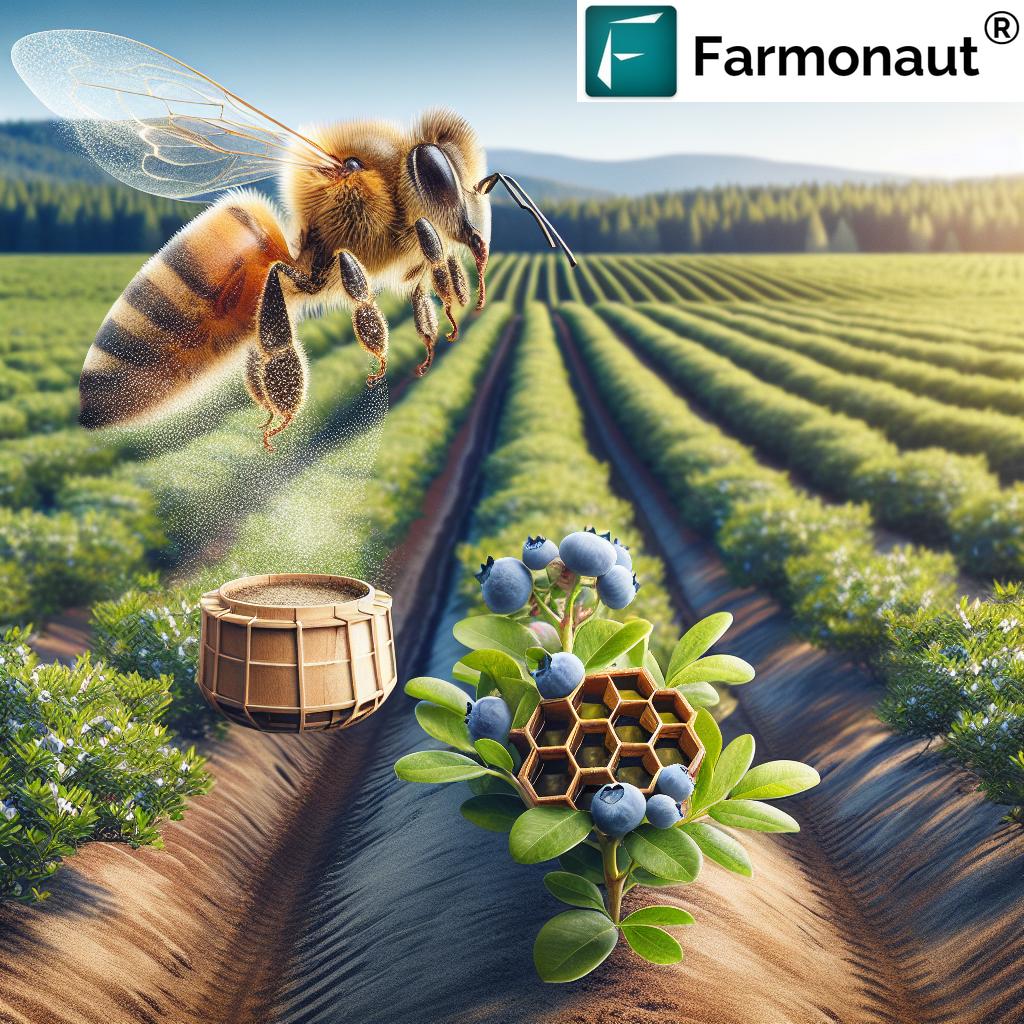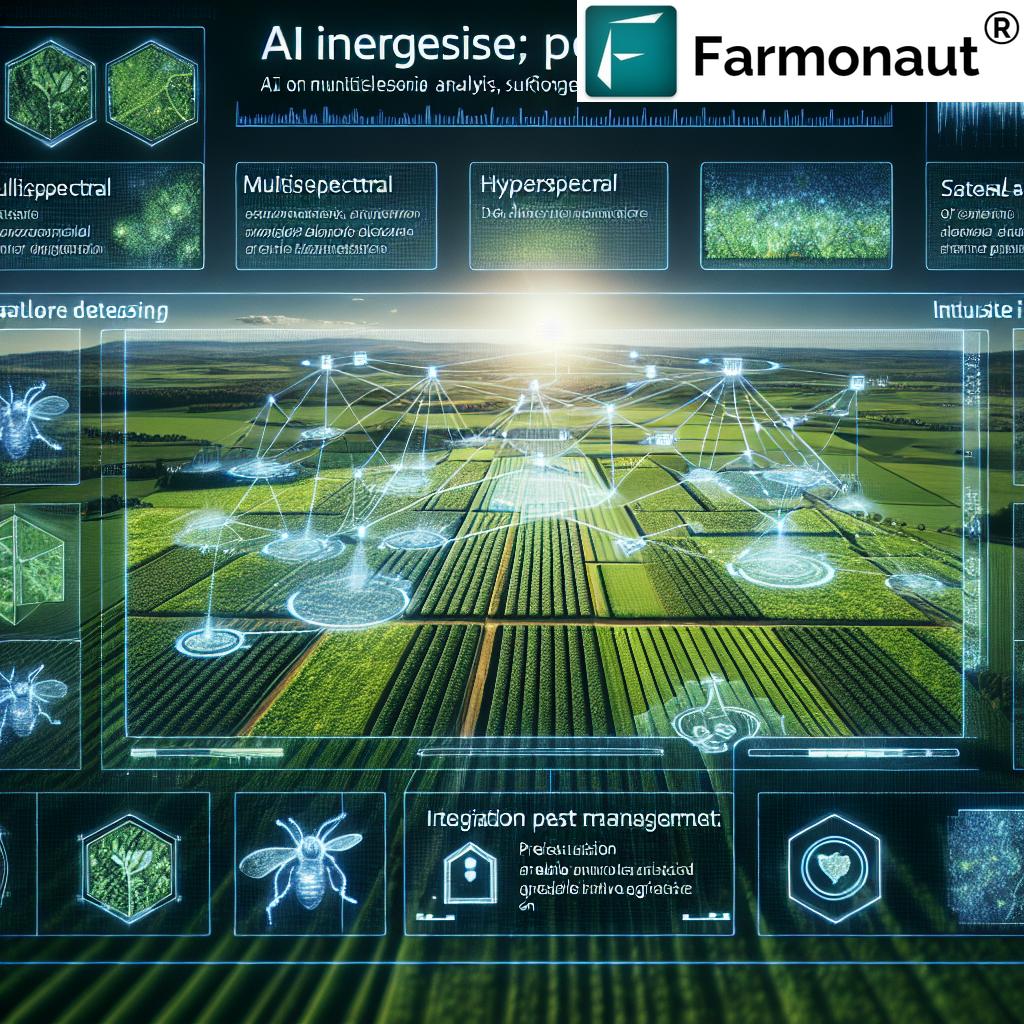Circular Farming System: Farmland Mounting Bulk Solutions
Table of Contents
- Introduction: The Need for Sustainable Agriculture in 2025
- Trivia
- Understanding the Circular Farming System
- Key Components of the Circular Farming System
- Agricultural Farmland Mounting System Bulk Solutions
- Synergy: Integration of Circular and Mounting Systems
- Farmonaut: Innovating Circular Agriculture Monitoring
- Comparative Benefits Table: Traditional vs. Circular Farming with Mounting Solutions
- Future Trends and Predictions (2025 and Beyond)
- Farmonaut Subscription Options
- Frequently Asked Questions (FAQ)
- Conclusion
“Circular farming systems can reduce farm waste by up to 80%, significantly boosting resource efficiency and sustainability in agriculture.”
Introduction: The Need for Sustainable Agriculture in 2025
In 2025, agriculture faces a host of global challenges that continue to intensify: soil degradation, shifting climates, dwindling resources, and rising food security concerns. Modern populations demand more from our farmlands, spurring the ongoing innovation of circular farming system, agricultural farmland mounting system bulk solutions. This article explores how circular farming approaches, when coupled with advanced mounting systems, represent a transformative leap forward—enhancing both sustainability and productivity for current and future generations.
Adopting a circular model means letting go of the conventional, linear “take-make-dispose” pattern that has defined agriculture for decades. Instead, we emphasize resource reuse, recycling, regeneration, and restoration—building resilient farms that thrive with fewer inputs and far less waste. Advanced agricultural farmland mounting system bulk infrastructures extend this model further, allowing for the seamless integration of sensors, renewable energy panels, IoT frameworks, and modular agricultural equipment.
By 2025, these innovations are not just conceptual but are actively reshaping the way we approach farming at scale. Our focus in this blog: How the circular farming system, agricultural farmland mounting system bulk solutions deliver on the promises of efficiency, environmental stewardship, and economic sustainability.
Understanding the Circular Farming System
The circular farming system is inspired by the principles of the circular economy—a framework that views waste not as an endpoint, but as a new beginning within the agricultural ecosystem. In a circular model, every output, whether organic waste, animal manure, or crop residues, is transformed into valuable input for subsequent cycles.
- Unlike conventional systems, which follow a straight “use and discard” trajectory, circular farming systems are closed-looped, continuously regenerating their core resources.
- Recycling, reuse, and regeneration are placed at the heart of daily operations, reducing dependence on synthetic fertilizers and limiting waste minimization.
This shift reduces environmental impact, lowers costs, and helps farmers meet the rising demand for sustainable, future-ready agriculture.
Why Is a Circular Farming System So Crucial in 2025?
- Addressing Land Degradation and Climate Change: Recycling nutrients and maintaining soil fertility counters nutrient depletion and ongoing climate fluctuations.
- Mitigating Resource Scarcity: By optimizing every input, water, energy and soil health are preserved.
- Ensuring Food Security: Circular systems increase productivity and resilience, vital for feeding rising populations amidst uncertainty.
The overarching goal is clear: Build ecosystems and farm operations that thrive now and for the generations to come.
The Circular Farming System: Key Principles
- Resource Efficiency:
Every input, from water to nutrients, is cycled and recaptured where possible. This means reducing waste and maximizing output per resource unit. - Waste Minimization:
Organic and inorganic byproducts are composted, recycled, or repurposed instead of being discarded. For instance, animal manure and crop residues can be converted to nutrient-rich compost. - Ecosystem Restoration:
Through agroforestry, crop diversification, and habitat creation, biodiversity is fostered—making farms more resilient to disease, weather, and pests. - Regenerative Inputs:
Renewable energy and biological cycles sustain operations, minimizing chemical and fossil fuel dependence. - Closed-Loop Operations:
Outputs are continually looped back into the system, whether as composted soil, recharged water, or energy through solar and bioenergy solutions.
Key Components of the Circular Farming System
To truly capture the benefits of a circular farming system, every aspect of the farm operation—from inputs and processes to outputs and waste recycling—must be reimagined and optimized:
-
Nutrient Recycling & Soil Health:
- Crop residues and animal manure are composted and returned to the soil, boosting organic matter, structure, and long-term fertility.
- Minimizes dependence on synthetic fertilizers and reduces off-farm nutrient loss.
- Supports carbon sequestration, which is pivotal for reducing agriculture’s climate impact.
-
Water Conservation:
- Collection of rainwater through harvesting systems.
- Utilization of precision irrigation technologies (like drip or pivot systems) to dramatically minimize water wastage.
- Closed-loop water recycling for ongoing hydration of crops and livestock.
-
Biodiversity Promotion:
- Crop rotation, intercropping, and agroforestry foster diverse soil microbes and beneficial insects.
- Creation of pollinator habitats, supporting bees and other essential species for resilient yields.
-
Renewable Energy Integration:
- Use of solar panels, bioenergy sources, and wind solutions for powering farm operations.
- Reduces overall carbon footprint and dependence on fluctuating energy prices.
-
Waste Downcycling & Upcycling:
- Transforming unavoidable farm waste into alternative feedstocks or new revenue streams (e.g., biochar or bioplastics).
- Further supporting a resilient farm economy.
“Agricultural farmland mounting systems can improve land productivity by as much as 25% through optimized use of space and resources.”
Agricultural Farmland Mounting System Bulk Solutions
To realize the potential of the circular farming system, farms need infrastructure that is flexible, modular, durable, and specifically designed for the demands of modern, technology-enabled operations.
The agricultural farmland mounting system bulk solutions are engineered frameworks and mounts that allow swift installation and rearrangement of essential equipment, sensors, solar panels, and more across vast farmlands. Their modular design is tailored to fit the rapidly evolving landscape of precision agriculture and renewable resource integration.
Core Features of Advanced Mounting Systems
- Highly Adaptable and Modular:
- Configurable racks and mounting structures allow multiple uses—quickly supporting various IoT sensors, irrigation equipment, and solar arrays according to real-time needs.
- Environmental Durability:
- Materials are chosen for resistance to harsh climates, UV, wind, corrosion, and pests—maximizing investment lifespan.
- Integrated Digital Agriculture:
- Farmers can deploy advanced sensors for soil health, water monitoring, nutrient cycles, and pest management—enabling continuous, data-driven optimization.
- Scalable Renewable Energy Installations:
- Frameworks easily integrate solar panels and wind generators, delivering carbon-free power to irrigation pumps, climate control, and storage facilities.
- Centralized Data Collection Hubs:
- Act as a spine for monitoring equipment health, ensuring optimal performance and rapid troubleshooting.
Impact of Mounting System Bulk Solutions for Agriculture
- Enabling Precision Agriculture: With modular mounting, precision applicators for nutrients, irrigation, and crop protection can be dynamically placed for maximum effect.
- Supporting Farm Sustainability: Robust, reconfigurable systems ensure ongoing monitoring and optimization—reducing waste and making every hectare count.
- Simplifying Operations: Bulk systems mean fewer individual installations—saving time, labor, and cost, and easier scalability as farm needs evolve.
- Technological Future-Proofing: As AI, sensor technology, and renewables advance, the mounting frameworks provide a backbone for rapid adoption and integration.
Use Cases of Mounting Systems in Circular Agriculture
- Mounted sensors monitor compost temperature and decomposition, ensuring complete nutrient recycling and safer, more effective organic fertilizers.
- Solar panels atop mounting racks power precision irrigation directly in fields—minimizing transmission loss, reducing water waste, and leveraging clean energy.
- Frameworks hold cameras and drones for automated crop health and yield estimation, dramatically improving insight for planning.
Synergy: Integration of Circular Farming System and Mounting System Bulk
The true shift in sustainable agriculture happens when these two innovations—circular farming systems and agricultural farmland mounting system bulk—converge. Their integration enables what a single model cannot achieve alone, especially in 2025 and beyond:
How Integration Drives Modern Agricultural Excellence
- Optimized Resource Use:
Sensors and precision equipment, easily mounted and repositioned, guide targeted deployment of water, nutrient inputs, and crop protection. This means less waste, better yields, and radically improved resource efficiency. - Zero Carbon Energy:
Solar- and wind-powered mounting structures supply renewable energy for all critical farm operations, from irrigation pumps to AI data centers, reducing fossil fuel dependence and mitigating climate change. - Compost and Waste Monitoring:
Real-time monitoring platforms, mounted across fields, ensure organic wastes are efficiently recycled and fully composted before returning to the soil. This guarantees optimal nutrient cycling and carbon emissions tracking. - Increased Resilience and Flexibility:
Data collected from diversified landscapes enables farmers to rapidly adapt to weather, pests, and disease outbreaks—critical for maintaining farm stability in an era of climate uncertainty. - Boosting Biodiversity and Soil Health:
Integrated mounting solutions empower agroforestry, crop rotation, and pollinator-friendly habitats, all while making room for renewable infrastructure.
By fusing circular farming principles with flexible mounting system bulk solutions, farmers can slash waste, conserve critical resources, maximize productivity, and ensure long-term sustainability and resilience.
Example: A Day on a Future-Ready Circular Farm (2025)
At sunrise, solar panels on modular mounts begin powering irrigation and data collection systems. Soil monitors—fed by data from satellite-based platforms like Farmonaut—detect low moisture in a field. Precision sprinklers are automatically activated for just the necessary locations, reducing water waste. The heat from compost piles, measured by mounted temperature sensors, signals the compost’s readiness to return to fields, closing the nutrient recycling loop. Fleet management software dynamically allocates equipment based on real-time needs, increasing efficiency across the operation.
Get real-time farm insights, environmental impact analysis, and AI-powered advisory with the Farmonaut platform—available on web, Android, and iOS!
For developers and agri-tech GIs, integrate advanced satellite-based monitoring directly into your applications using Farmonaut’s Satellite API. Find detailed developer resources in the API Documentation.
Farmonaut’s Large Scale Farm Monitoring enables comprehensive crop, water, and soil monitoring via satellites, helping optimize resource management for expansive and multi-site operations.
Supporting crop traceability? Leverage blockchain-based traceability for transparent, trusted food supply chains—ensuring sustainability claims are verifiable from soil to shelf.
Need to guide plantation forestry or maximize agroforestry’s role in circular farming? Explore the AI Advisory features, which offer location-specific, data-driven guidance for maximal biodiversity and carbon sequestration on your land.
Farmonaut: Innovating Circular Agriculture Monitoring in 2025
As sustainable agriculture continues to evolve in 2025, the adoption of circular farming system, agricultural farmland mounting system bulk technologies places a premium on timely, precise, and scalable monitoring. This is where Farmonaut’s satellite-based solutions make a critical difference:
- Satellite Imaging for Soil, Crop, and Water Health: Multispectral imagery delivers field-wide data on vegetation vigor (NDVI), soil fertility, and water stress, forming the backbone of resource-saving circular strategies.
- AI-driven Forecasting & Resource Planning: Farmonaut’s advisory systems interpret global environmental signals, rainfall, and climate fluctuations, empowering proactive management of irrigation, nutrient recycling, and farmland productivity.
- Blockchain Traceability: Ensures that claims of sustainable inputs, waste reduction, and circular processes are transparent and auditable along the supply chain.
- Environmental Impact Monitoring: With real-time carbon footprint tracking, Farmonaut empowers users to adjust practices and maintain compliance with environmental standards.
- Fleet and Equipment Management: Farmonaut’s fleet management platform optimizes equipment utilization and reduces energy waste—key for large-scale mounting and deployment needs.
Our mission is to make satellite-driven farm insights and resource optimization affordable and accessible for every farmer, business, and government actor—fueling the next evolution in sustainability, resilience, and productivity, all within one modular, cloud-powered interface.
Comparative Benefits Table: Traditional vs. Circular Farming with Mounting Solutions
| Farming System Type | Estimated Resource Use Reduction (%) | Estimated Waste Reduction (%) | Estimated Yield Improvement (%) | Sustainability Index (Estimated Score) | Example Practices |
|---|---|---|---|---|---|
| Traditional Linear Farming | 0–5% | 0–15% | 0–7% | 45/100 | Pesticide-reliant monoculture, open irrigation, synthetic fertilizers, basic mechanization, conventional tillage |
| Circular Farming with Mounting Solutions | 30–50% (water), 20–35% (energy) | 40–80% | 12–25% | 83/100 | Precision composting, solar-powered irrigation, adaptive mounting frameworks, sensor-driven nutrient recycling, agroforestry diversification, carbon monitoring |
The data above underscores why circular farming system, agricultural farmland mounting system bulk is increasingly recognized as the foundation for a resilient, profitable, and sustainable agriculture paradigm in 2025.
Future Trends and Predictions for Circular Farming System, 2025 and Beyond
Ecosystem-Driven, Climate-Smart Agriculture
-
Widespread IoT Integration:
Farms will see almost every process monitored and automated with sensors on robust mounting systems—ensuring ongoing adaptation and efficiency. -
Expansion of Renewable Infrastructure:
Solar, wind, and even bioenergy platforms integrated into farmland design—not only powering farm operations but exporting green energy during surplus. -
Data-Backed Decision Support:
Insights from providers like Farmonaut help users forecast nutrient cycles, pest outbreaks, and yield projections with increasing precision, minimizing risk and maximizing output. -
Traceability as a Standard:
Supply chain transparency (via blockchain) will become a market norm, ensuring authentic sustainable practices and compliance. -
Carbon Markets & Incentives:
Farms practicing advanced circular systems could monetize their reduced carbon footprint and ecological services through verified environmental credits. -
Global Policy Convergence:
Circular agriculture and modular technological solutions will be prioritized in policy for ecological restoration, food security, and climate adaptation worldwide.
Staying ahead in agriculture means embracing these trends—melding traditional knowledge with next-gen, circular technological frameworks for continuous progress.
Farmonaut Subscription Options
For agricultural businesses, large enterprises, and governments, our modular subscription model delivers unparalleled value—enabling scalable access to satellite analytics, AI-based recommendations, and blockchain traceability solutions. Find the best fit for your needs and start enhancing your farm’s sustainability and productivity today.
Frequently Asked Questions (FAQ)
What is a circular farming system?
A circular farming system is a farming approach that prioritizes resource reuse, recycling, and regeneration within the agricultural ecosystem—minimizing waste, chemical inputs, and environmental impact while maintaining or enhancing productivity and resilience.
How does an agricultural farmland mounting system bulk solution work?
These are modular infrastructures—including racks, mounts, and frameworks—designed for rapid, flexible deployment of farm technologies like sensors, renewable energy panels, and precision agriculture machinery. They enable careful, efficient use of space and resources, powering the integration of sustainable technologies at scale.
Can circular and mounting systems really reduce farm waste by 80%?
Yes. Through composting, recycling, resource targeting, and digital monitoring, circular farming and mounting system integration has been shown to reduce waste by up to 80%, amplifying sustainability for both small and large-scale farms.
Do I need a large farm for these systems to be valuable?
No—modular mounting system bulk solutions and circular techniques are adaptable for any scale, from smallholder plots to industrial-sized farmlands. Modular design and real-time data monitoring make these systems effective and scalable for everyone.
How can I monitor my farm’s progress toward sustainability?
Satellite-based solutions such as those provided by Farmonaut deliver continuous, real-time data on crop, soil, and water health, along with carbon footprint and resource use. These insights help users track progress, benchmark impacts, and unlock efficiency gains with confidence.
What are the economic benefits of switching to circular farming with mounting systems?
Significant reductions in input costs (fertilizers, water, energy), reduced waste handling costs, increased yields, and potential new revenue streams from sustainable certifications and carbon credits make the economic case for circular farming system, agricultural farmland mounting system bulk solutions very persuasive.
How do I get started with these systems?
Start with a field assessment—applying smart sensors (which can be easily mounted with bulk solutions) and analyzing current resource flows. Tools like Farmonaut’s satellite monitoring and AI advisory provide actionable intelligence for optimal next steps, regardless of your farm size.
Conclusion: Circular Farming System, Agricultural Farmland Mounting System Bulk—2025 and Beyond
The adoption of the circular farming system, agricultural farmland mounting system bulk is no longer a trend—it’s a necessity. These frameworks represent a paradigm shift in agriculture: a new era defined by resource efficiency, environmental stewardship, and technological integration.
By 2025, forward-looking farms will be those that maximize their outputs while minimizing both waste and environmental impact. Integrating circular models with advanced mounting solutions ensures that we reduce, reuse, and regenerate throughout the cycle—ensuring smarter, more resilient food systems for all.
As we look toward the future, let us remember: What we build today becomes the ecological and economic foundation for generations to come. Let’s seize the opportunity to transform agriculture, ensuring sustainability, food security, and prosperity—for ourselves and the planet.
If you’re ready to optimize your farm’s operations, monitor environmental impacts, and join the movement toward sustainable, data-driven agriculture, explore Farmonaut’s platform and products today!












